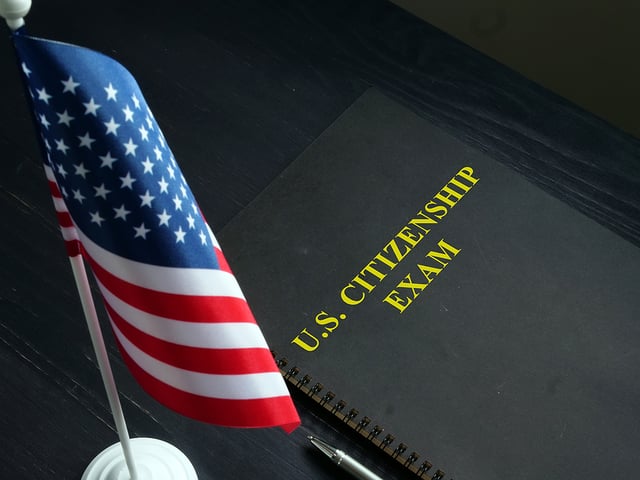
Reading on the U.S. Citizenship Test
The U.S. Naturalization (or Citizenship) Test is made up of three sections: U.S. History and Civics, Reading in English, and Writing in English. These three tests may be conducted by the immigration officer in any order, so be ready.
About the Entire Test
-
The U.S. History and Civics test comprises 10 questions, asked by the officer orally and answered by the applicant orally. You must answer six of the ten questions correctly in order to pass that section of the test. Once you answer six correctly, the officer will not ask you any further history or civics questions.
-
The Reading and Writing tests each have three sentences. To pass these sections, you must answer one reading and one writing question correctly. You have up to three chances in the reading section and three chances in the writing section to respond correctly.
About the Interview
When you meet with the immigration officer, he or she will review your Form N-400 application with you. This gives the officer an opportunity to assess your ability to speak and understand English, part of the requirements for the process of naturalization. Once the paperwork has been reviewed, the testing will begin.
The Reading Test
The reading component to the Naturalization Test is relatively quick. The immigration officer will show you a paper with three sentences on it and will ask you to read one of the sentences aloud. At this point, you will read the selected sentence, using clear enunciation and correct pronunciation as best you can.
What Are They Looking For?
The officer is not looking for perfection here and any accent you may have will not affect your ability to pass the reading test. What the officer is looking for is reading so that someone else can understand you. If you can do that, you will pass.
How Many Chances Do I Have?
If accepted, the officer will move on to another portion of the test. If you were unable to read the sentence clearly, the officer may ask you to read another one of the sentences. You have three opportunities to read a sentence correctly to pass this portion of the test.
What Kinds of Things Will I Read?
The sentences will generally relate to U.S. civics, government, or history, so it’s a good idea to be familiar with some of the vocabulary the government is testing you on. Here is a link to the reading vocabulary list for the Naturalization Test. The list is also reproduced in the table below.
| People | Civics | Places | Holidays | Question Words |
Verbs | Other (Function) |
Other (Content) |
|---|---|---|---|---|---|---|---|
| Abraham Lincoln |
American flag |
America | Presidents’ Day |
How | can | a | colors |
| George Washington |
Bill of Rights |
United States |
Memorial Day |
What | come | for | dollar bill |
| capital | U.S. | Flag Day | When | do/does | here | first | |
| citizen | Independence Day |
Where | elects | in | largest | ||
| city | Labor Day | Who | have/has | of | many | ||
| Congress | Columbus Day |
Why | is/are was/be |
on | most | ||
| country | Thanksgiving | lives/lived | the | north | |||
| Father of Our Country |
meet | to | one | ||||
| government | name | we | people | ||||
| President | pay | second | |||||
| right | vote | south | |||||
| Senators | want | ||||||
| state states |
|||||||
| White House |
Practice Speaking
To prepare for the reading portion of the Naturalization Test, it’s a good idea to get as much practice reading and speaking English words as possible. The more often you can engage in speaking English and practicing pronunciation, the better! Practice your English around friends and co-workers and ask them for feedback about your pronunciation. This will help your confidence as you’re reading because you will feel more comfortable with how to say the words as you read them.
Practice Reading
Practice reading in English anywhere and everywhere you go! The opportunities to practice reading in English are countless. Read billboards and signs and read packaging labels on products in the store. Read newspapers at the coffee shop or browse the magazine headlines while you’re standing in line at the grocery store. If you have school-age children, read with them. Have family read-arounds where you share the task of reading one page, paragraph, or sentence at a time. This will help build your fluency and confidence in reading.
Other Test Preparation
It’s also a good idea to practice with the interactive practice tests offered online here at Union Test Prep and on the uscis.gov website to get a sense of the vocabulary expectations and sentence types.
Final Tips for You
Although you are likely to be nervous during the test, try to relax. Ask the officer to repeat something if you don’t understand. Take your time and take a deep breath. You are on the road to becoming a U.S. citizen—congratulations!
Keep Reading

The Naturalization Interview and Tests Blog
How to Do Well on the U.S. Citizenship Test
If you’re on the path to becoming a U.S. citizen, one important step yo…

The Naturalization Interview and Tests Blog
Writing on the U.S. Citizenship Test
Applying to be a U.S. citizen is a long and complex journey. By the tim…

The Naturalization Interview and Tests Blog
Are You a Good Candidate for the U.S. Citizenship Test?
Many immigrants hoping to become citizens of the United States apply to…